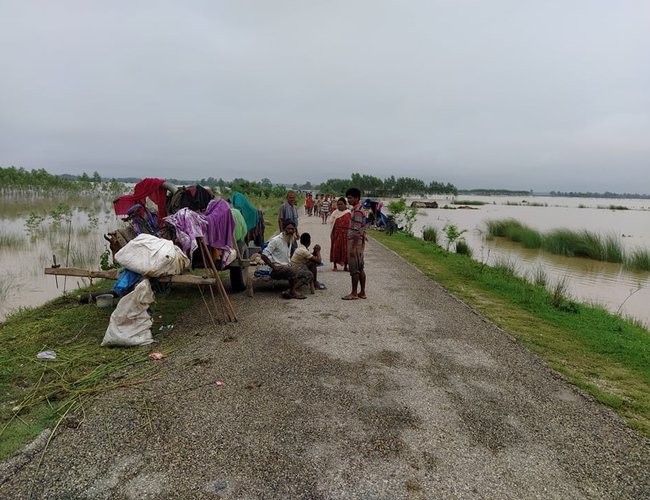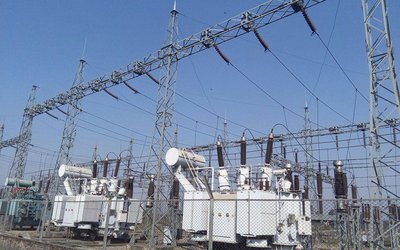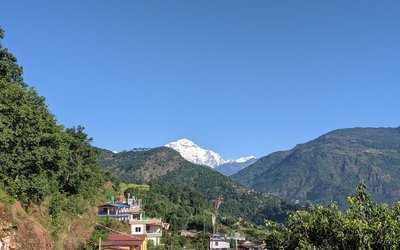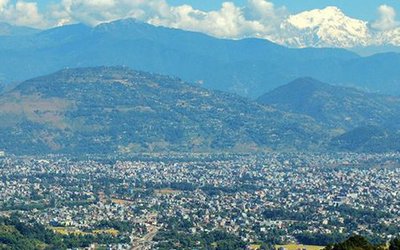
Nepal is exposed to multiple natural disasters such as earthquake, flood, landslide, hailstorms, droughts and many more due to the country's varying climatic condition and diverse topography. Environmental degradation and the impacts of climate change have further aggravated the vulnerability of the country from such natural disasters. As per a report by the Ministry of Home Affairs, Nepal ranks 4th, 11th and 30th with regard to vulnerability from climate change, earthquake and floods respectively amongst the 200 countries around the world.
Torrential rains that takes place during monsoon season every year causes numerous flash floods and landslides in hilly regions and massive inundation in the plains-Terai regions of the country which not only leads to the huge number of human fatalities and human displacement, moreover, add to the destruction of hundreds of households,perishes livestock and also sweeping away of the public infrastructures like bridges and highways, schools and colleges, disturbing irrigation and drainage systems, blockage of water supply and many more. All these contributes to pre-disaster, during disaster and post disaster mitigation failures, because of paucity of trained human resources and financial resources, more than that lack of crisis management. The disaster response mechanism, crisis communications system, decision-making and healthcare facilities are besieged. In Nepal, the crisis managers themselves seemed becoming first sufferers of disaster with their indecisiveness and stagnancy.
Haphazard and unplanned urban development leading to sprawling urban settlement is another major issue that has created numerous problems in the major cities of Nepal, especially the capital of the country, Kathmandu. Encroachment of public lands and the river banks has been the major issues due to the unplanned and uncontrolled settlements. The repercussions of these factors are more profound during the occurrence of natural disasters like earthquake, heavy monsoon and floods.The Bagmati river, which flows through the valley used to be almost 100-150 metres in natural width three decades ago, is today lessened to 10-15 metres in many locations within the city area. Consequently, every year during the monsoon season, the river enters the densely populated neighbourhoods causing havocs in the lives of the citizens and damage and loss of properties worth millions.
Not only floods, the frequently occurring earthquakes are nerve wracking to the Kathmanduities and hugely affecting their everyday lives. According to a report published in 2017 by the Global Facility for Disaster Risk Reduction and Recovery, Kathmandu is one of the riskiest urban cities in the world in terms of seismic events. These are proved by the fact that several earthquakes have occurred in the history of Nepal time and again over the years; the major ones being the massive earthquake in 1934and 2015.
With the onset of COVID-19, experts around the world have come to the conclusion that the pandemic is the result of the human interferences and altercations to the nature,and vice versa. Because of this, it is believed that the risk associated with the environmental hazards has been exacerbated with the outbreak of the virus. Further, the government has failed to see the interconnection between COVID-19 and environmental concerns. The recent decision by the government to increase the custom duty and excise taxes on the Electric Vehicle (EV) in the Budget of the Fiscal Year 2020-2021 is a glaring proof of that. The policy should be to minimize the use of fossil fuel and growth of renewable energy.
As it is a known fact that air pollution leads to various respiratory illnesses such as asthma and other chronic lung ailments, people with such pre-existing conditions are found to be more susceptible to COVID-19, placing them in more vulnerable place compared to those people with no such illnesses. The policy requirement is to decrease the air pollution in the urban centres of Nepal and elsewhere. The decision taken by the government to increase the duty and taxes on EV has shown that the government of Nepal has reversed from its pasts commitment of addressing and prioritizing the environmental concerns and public health issues.During the pandemic, the major concern of the government should be to ease the availability of basic necessities such as day-to-day reusable masks, face-shields, protective spectacles and head gears, standardsanitizers, ventilators, oxygen cylinders, mobile disinfectant tunnels to be used in crowded and public places etc. rather thanhave policies which are directed in other unimportant areas.
Government of Nepal has framed various national policies focussed on environment time and again and has also shown commitment towards the environmental issues by supporting international frameworks and agreements. International organizations like the United Nations Office for Disaster Risk Reduction (UNDRR), United Nations Development Programme (UNDP) and the Asian Disaster Preparedness Center (ADPC) which is a leading regional resource center in the Asia and Pacific have been providing comprehensive technical support to the government in formulating the government's disaster related policies and developing their capabilities in various aspects of disaster management. But Government of Nepal seems not been able to fully utilise the resources and support provided by these organizations. Although government has shown some level of commitments towards them in theory but when it comes to action, it has not been able to show the same level of dedication. Why is this happening? It is a serious governance issue that need diagnosis. This clearly depicts there is a lacuna between the theory and practice concerning disaster in Nepal.
Environment and climate change are intertwined as increase in pollution and environmental degradation contributes to climate change and climate change further increases the risk of natural disasters. As it has been noticed by all, since the lockdown started, plying of vehicles stopped completely which led to drastic decrease in the air pollution level in the cities around the world. A report shows that due to the drop in the carbon emissions, the world's popular touristic city Venice have seen significant decrease in the air pollution. The water pollution has also dropped substantially leading to cleaner Venice canals with clear visibility of beautiful fishes once again after decades. In Paris, the air became cleaner as it was about 40 years ago as shown in a report by the National Geographic. In Kathmandu too, the natives have observed the humming of the birds of certain species which were never heard before and it has been reckoned as the result of the radical drop in the air and sound pollution level.
In this regard, the environmental experts believe that if the use of fossil fuel-based vehicles ply less in Kathmandu valley, the air quality automatically improves, which results in less impact on the environment by the climate change at large. The erratic weather condition caused by the climate change also drops if citizens opt for Electric Vehicles (EV) over fossil fuel-based vehicles keeping the environmental concerns in mind which contributes towards the overall risk associated with the occurrence of several natural disasters.
Although the natural disasters affect everyone equally, the impacts of the disasters and their vulnerabilities are not gender-neutral as women, disadvantaged and minorities groups are affected more than the others. This has been observed not only in Nepal but in different countries around the world. As per a report by the UNDRR, during the 2004 Tsunami, women and children in Indonesia made up 77 percent of the total victims. Similarly, a report published by Japanese International Cooperation Agency (JICA) shows that during the Great East Japan Earthquake in 2011, the death of people with disabilities was more than double to that of people with no disabilities. According to the report, while 4.5 percent of the overall population were found dead as the result of the earthquake, the death rate of people with disabilities was 13 percent.
Not only the effects of the disasters but the recovery and relief efforts after the disasters are also not gender-neutral in nature. Example of such can be taken from that of the 2008 Koshi River flooding in Sunsari and Saptari districts in Nepal. In the aftermath of the flood, many "Natuwas" (dancers, who belong to LGBTQI) in the Sunsari district, reported that they faced discrimination in the rescue and relief efforts. In Nepal, usually the relief measures are disaggregated by two genders: female and male, hence the people having the status of "third gender" are left out in these processes.
Insufficient awareness and preparedness, inefficient enactment of the legislations with regard to disaster risk reduction and management, lack of enforcement of laws, lack of political commitment concerning disasters, below-par building and construction practices are some of the major factors that are contributing towards the increased susceptibility from the several disasters and increased gender inequality faced by the citizens of Nepal in regard to such disasters. Although Nepal has introduced various laws regarding the disaster risk reduction and management, there are several ambiguities and substantive progress needs to be done so that the implementation of the laws and policies are rendered effective.
What then?
Disaster Risk Reduction (DRR) being the major component to achieve sustainable development, it requires the "All of Society Inclusive Approach". This approach is vital to achieve inclusivity in the management of DRR and to achieve the goals set by the Sendai Framework, which was adopted at the Third World Conference on DRR in 2015 held in Sendai, Japan. Mainstreaming gender in DRR helps focus on distinct gender-specific aspects of the vulnerabilities resulting from the disasters and the ways to prevent, prepare, mitigate and recover from them without ignoring the consideration of the gender perspective to it.
Empowerment of women is vital in building disaster resilience in the country hence promotion and encouragement of women for their equal participation in all the phases of the DRR needs to be practiced. As women are the key stakeholders in the successful management of the disaster risk and also in implementing the gender-sensitive plans and policies, their voices need to be represented at all three tiers of government: local, provincial and federal. After the promulgation of the Constitution of Nepal 2015, the system consists of these three tiers of government because of which government now needs to have clarity in division of responsibilities and utilisation of funds in each of these levels efficiently.
As risk governance is a critical aspect of DRR, all facets of the risk governance should be gender-sensitive in nature. Similarly, formulating gender-responsive plans and policies are not alone enough but establishing gender-responsive accountability and monitoring mechanisms is vital for the successful management of the disasters. Systematic collection of the sex-disaggregated data needs to be carried out and gender analysis should be done in order to find out the differential impacts of the disasters in various genders.
Furthermore, as Nepal lacks the effective communication and Early Warning Systems (EWS) which becomes indecisive and paralysed during the occurrence of the major disasters, development of the competent early warning systems needs to be done and training needs to be provided to the human resources on those. Such actions will ensure the effective implementation of information system which is gender-responsive and such systems will help make the crisis communication easier and reachable amongst the communities living in the most rural areas of the country for crisis management. The first one hour is the Golden Hour in any crisis management hence the communication and rescue both needs handling before the Golden Hour elapsed, to save precious lives.
The disaster risk management strategies need to be accompanied by a careful consideration of its strengths and weaknesses of Nepal's institutional capacity.Moreover, the institutional capacity for disaster mitigation and management must be robust. The immediate rescue component post 2015 earthquake in Nepal was dealt commendably by the frontline organs of the government- the army, armed police, health workers and healthcare centres, however Nepal utterly failed to conduct post-disaster SWOT analysis, to understand it's political and institutional strengths, weaknesses, opportunities and threats, before another pandemic fall upon Nepalese people with 5-year period.
The natural hazards are under nobody's control, when it happens it takes the toll. However, it should not add more threats and challenges to the Nepal's sustainable development. Hence, the Government of Nepal should have institutional arrangements in place, that can rapidly respond and cope with any large-scale disasters befallen at any place and anytime of the year. Lastly, government should pledge to strengthen and mainstream DRR in all its development plans and programs and fulfil its commitment towards efficient disaster management in the real sense through coherent actions.
The author holds a Master of Science degree in Gender and Development Studies from the Asian Institute of Technology (AIT), Thailand.
- Youth In Politics: A Present Day Context
- Apr 24, 2022
- Turning The Tide: Addressing Gender Biases In Media
- Aug 25, 2021
- How COVID-19 Threatens The Future Of The Children, Especially Young Girls?
- Apr 25, 2021
- Women's Representation In Politics: Just A Tokenism
- Feb 06, 2021
- Women Migrant Workers And Their Human Rights
- Dec 27, 2020
















